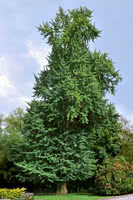Mon-Fri 9am - 5pm Mountain time
Ginkgo Biloba vs Western Red Cedar
Ginkgo biloba
Thuja plicata
NOT AVAILABLE THIS SEASON - MIGHT RETURN
NOT AVAILABLE THIS SEASON - MIGHT RETURN
The Ginkgo Biloba is regarded as one of the most distinctive and beautiful of all the deciduous trees, and has remained genetically unchanged for millions of years. Its beautifully fan-shaped leaves develop a clear yellow colour in fall. Graceful and attractive year-round, Ginkgo is the perfect conversation starter in your yard.
Western Red Cedar is native to the Pacific Northwest, and is the largest tree in the cypress family. Featuring horizontal branching with scale-like dark green foliage that has a strong aroma. The wood is naturally durable and light, and is resistant to decay and insects, making it sought after for house siding, paneling, furniture, and fences. This is British Columbia's official tree.
Ginkgo Biloba Quick Facts
Western Red Cedar Quick Facts
Toxicity: Uncooked nuts in large quantities

